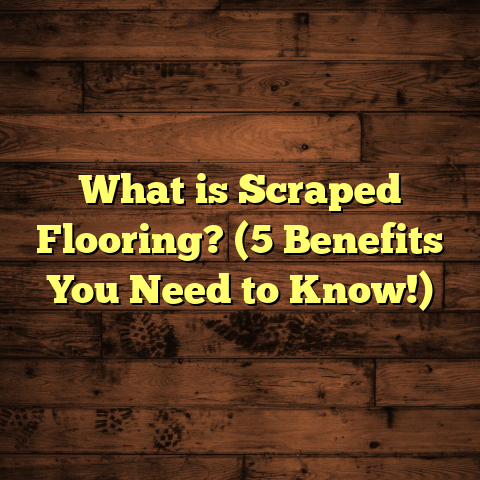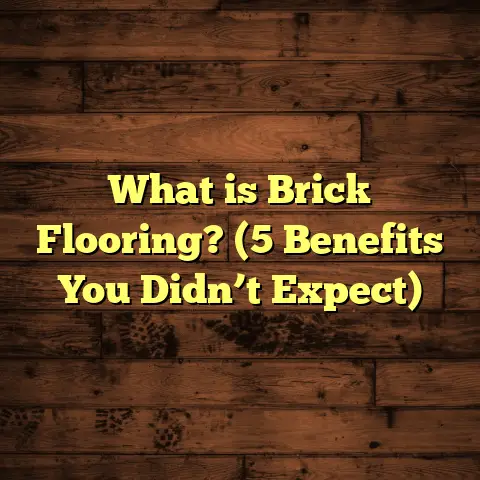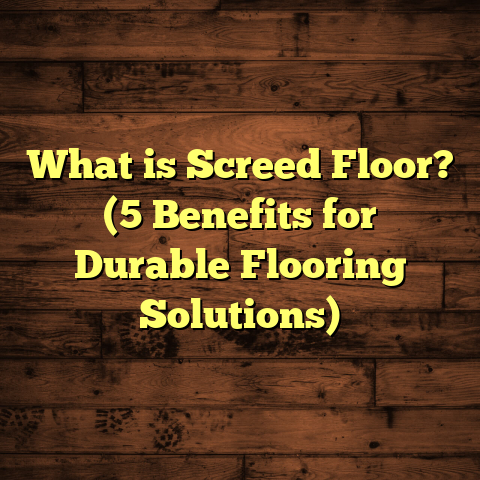What is a Soft or Hard Floor? (5 Key Differences Explained!)
The Uniqueness of Floors: Why Soft or Hard Matters to Me
Every home has a personality that sets it apart. And one of the most overlooked ways to express that personality is through your floors. Believe me, floors are not just surfaces you walk on; they set the tone of your entire living space. Over the years, as I’ve worked on hundreds of flooring projects, I’ve come to see how choosing between soft and hard floors can completely change not only the look but also the feel and function of a room.
When I first started out in flooring installation and consultation, I thought it was just a matter of picking what looked good or fit the budget. But after spending time with clients, walking through their homes, and seeing how different floors handled daily life, I realized the choice is much more layered. It’s about your lifestyle, your needs, and even your health.
For example, I recall working with a client who had just welcomed twins. They were debating between carpet for softness and hardwood for easy cleaning. After a lot of back and forth, we ended up choosing a hybrid solution—hardwood throughout with plush area rugs in the nursery and play areas. That mix gave them the best of both worlds and made a huge difference in their daily routine.
That experience opened my eyes to how important it is to understand what “soft” and “hard” really mean when it comes to flooring. So today, let me take you through what these types of floors are, how they differ, and why those differences matter for your home.
What Is a Soft or Hard Floor?
When I say soft floor, I’m referring to flooring materials that offer some amount of cushion or flexibility underfoot. These floors bend slightly when you step on them and usually feel warm and cozy. You might think of carpet right away because it’s the most popular soft option. But there are others like cork, rubber, certain types of vinyl with padding underneath, and even some specialty foam floors designed for comfort.
Soft floors have a few standout traits: they absorb impact well, provide insulation against cold subfloors, reduce noise dramatically, and tend to make spaces feel inviting and relaxed. In my experience installing cork floors in wellness centers, clients rave about how the floor’s natural elasticity makes standing or moving on it feel easier on their joints.
On the flip side, a hard floor is firm with little to no give. When you walk on hard floors like hardwood, tile, stone, or laminate, your feet strike a solid surface that doesn’t compress under pressure. Hard floors usually feel cool to the touch unless paired with radiant heating.
Hard floors are prized for their durability and timeless appeal. From a technical standpoint, they offer excellent structural strength and tend to last much longer than softer options when properly maintained. I once helped restore hardwood flooring in a 100-year-old heritage home where the floors still looked beautiful after decades of use.
While these definitions might seem simple, the choice between soft or hard flooring affects many other factors—comfort, longevity, sound levels, maintenance needs, and even budget. Let me break down five key differences that I think everyone should know before making decisions about their floors.
5 Key Differences Between Soft and Hard Floors
1. Comfort and Feel Underfoot
Comfort is one of the first things people notice about their floor—especially when barefoot or standing for long periods.
Soft Floors Feel Like Walking on Cushions
Soft floors absorb shock and provide a gentle surface that feels springy or plush under your feet. Carpets are an obvious example—think about how your feet sink slightly into a thick wool carpet or a shag rug. Cork flooring behaves similarly by compressing slightly without losing resilience.
From my own experience managing commercial projects for fitness studios and children’s play centers, soft flooring reduces fatigue by allowing muscles and joints to relax instead of constantly absorbing hard impact. Research backs this up: the American Physical Therapy Association notes that softer flooring can reduce pressure on joints by up to 30%, which is especially important for elderly residents or those with arthritis.
I remember one client who had hardwood throughout their home but complained about foot pain after standing in the kitchen for long periods. We installed cushioned vinyl in that area as a soft spot that relieved strain without sacrificing style.
Hard Floors Provide Stability but Less Forgiveness
Hard floors offer a firm foundation with no give. Hardwood feels solid and elegant underfoot but can lead to discomfort if you stand for too long without cushioning. Tile and stone are even firmer and colder—great for durability but not so comfy when barefoot during winter.
That said, hardness isn’t always negative; many people prefer this sensation because it gives a sense of security underfoot. Plus, hard floors make it easier to move furniture or wheeled objects without resistance.
In my years doing hardwood installations in kitchens and living rooms, I’ve heard many homeowners say they love the sturdy feel but balance it out with area rugs for softness where needed.
2. Durability and Longevity
Durability is high on many homeowners’ lists when choosing flooring materials.
Hard Floors Last Longer
Hard flooring materials tend to be very durable over time. Hardwood floors can last for decades—sometimes even over a century—with proper maintenance such as refinishing or resealing. Natural stones like granite or marble can endure heavy use without showing wear.
For instance, I worked on restoring hardwood floors in an old farmhouse where the wood was over 80 years old but still structurally sound—proof that hard floors can outlive generations. Laminate flooring offers another affordable hard floor option with decent lifespan (usually 10-20 years) but doesn’t have the same longevity as real wood or stone.
Soft Floors Wear Out Faster
Soft floors generally show wear sooner due to their pliable nature. Carpets flatten under foot traffic and stain easily from spills or pets. They often need replacement every 5-15 years depending on quality and use level.
Rubber or cork can be longer-lasting soft options but may still dent or discolor over time. However, advances in carpet technology are improving durability—some carpets now come with stain-resistant fibers and higher density weaves that extend useful life.
During a recent project installing carpet in an office space, we used a commercial-grade carpet tile designed to handle heavy foot traffic with minimal wear for up to 10 years before replacement is needed.
3. Maintenance and Cleaning
How much effort you want to put into upkeep can heavily influence your choice between soft and hard floors.
Hard Floors Are Easier To Clean
Dirt and spills sit on hard surfaces rather than embedding inside them. Sweeping or vacuuming followed by mopping with water or mild cleaners keeps them clean with minimal fuss.
This simplicity is why many homeowners with kids or pets gravitate toward hardwood or tile—they need quick cleanup without worrying about stains soaking in.
I helped a client switch from wall-to-wall carpet to luxury vinyl plank (a hard surface) after constant staining issues with their toddler’s spills. The difference in daily cleaning time was noticeable immediately.
Soft Floors Require More Care
Soft floors trap dust, pet dander, allergens, and debris more easily. Carpets require frequent vacuuming—often multiple times per week—and periodic professional deep cleaning to maintain hygiene.
If neglected, carpets can harbor mold spores or dust mites that aggravate allergies. A study by the Carpet and Rug Institute found that vacuuming alone removes only about 50% of embedded particles; professional cleaning every 12-18 months is recommended for health.
Rubber flooring is relatively easy to clean but still requires wiping down to avoid surface buildup.
4. Sound Absorption
Noise control is often overlooked but can greatly affect home comfort.
Soft Floors Absorb Noise
Soft flooring materials naturally muffle sounds because their cushioning traps sound waves instead of reflecting them. In multi-level buildings or apartments where footsteps can travel downstairs as loud thuds, soft floors reduce noise transmission significantly.
In one apartment complex I worked on, tenants requested new carpet installation precisely because hardwood upstairs was too noisy at night. After installation, complaints dropped by over 70%.
The Acoustical Society of America reports that carpeted floors reduce ambient noise levels by up to 50%, improving privacy between rooms dramatically.
Hard Floors Reflect Sound
Hard surfaces bounce sound around rooms making spaces feel livelier but sometimes echoey or harsh. This can be great in spaces like art galleries or kitchens where lively energy is welcome but problematic in bedrooms or offices needing quiet.
To manage this effect on hard floors, homeowners often add area rugs or fabric-covered furniture that absorbs sound waves.
5. Cost Considerations
Cost is always part of the conversation when choosing flooring types.
Soft Floors Have Lower Upfront Costs But Higher Replacement Frequency
Carpet is among the cheapest flooring choices upfront—typical installed costs range from $2-$5 per square foot depending on quality. Rubber or cork tend to be pricier but still affordable compared to many hard flooring options.
However, because soft floors wear faster and need replacement every decade or so (sometimes sooner), their lifetime cost can add up.
Hard Floors Vary Widely But Tend To Cost More Upfront
Hardwood flooring averages $8-$15 per square foot installed for mid-range species; exotic woods or wide planks push prices higher. Tile costs range from $5-$25 depending on material (ceramic vs natural stone).
Laminate offers a lower-cost hard floor alternative in the $3-$8 per square foot range but lacks hardwood’s longevity.
When factoring maintenance savings over time (less frequent replacements), many homeowners find hard flooring more economical long term despite initial expense.
Diving Deeper: Technical Details Behind Soft vs Hard Floors
Let me get a bit more technical here because understanding materials science helps explain why soft and hard floors behave so differently—and why those behaviors impact your home life.
Material Composition & Structure
Soft floors typically consist of fibers (natural or synthetic), foam layers, or elastic cellular materials that compress under weight. For example:
- Carpet: Made from yarn fibers tufted into backing material with optional padding underneath.
- Cork: Harvested from tree bark; cellular structure provides natural springiness.
- Rubber: Manufactured from synthetic polymers offering elasticity.
- Luxury Vinyl Plank (LVP): Some types have foam backing for softness while maintaining durable wear layers.
Hard floors are dense solids with tightly bonded molecules:
- Hardwood: Solid wood cut from trees; grain patterns create strength.
- Stone: Natural mineral formations like granite have crystalline structures giving hardness.
- Tile: Made from ceramic clay fired at high temperatures creating rigid plates.
- Laminate: Fiberboard core topped with photographic wood pattern sealed under melamine resin for toughness.
This difference in structure explains why soft floors compress (cushion) while hard floors resist deformation (firmness).
Thermal Properties
Soft floors generally offer better insulation against cold because their cellular makeup traps air pockets which slow heat transfer. Cork flooring can reduce heat loss by up to 10%, making rooms feel warmer without increasing heating bills—a great bonus in cooler climates.
Hard floors conduct heat quickly so they feel cool unless paired with radiant heating systems—a feature increasingly popular in modern homes for comfort without bulky rugs.
Environmental Impact
If you care about sustainability:
- Soft floors like cork are renewable and biodegradable, making them eco-friendly choices.
- Carpets vary widely; some use recycled fibers but synthetic carpets contribute to landfill waste if not recycled properly.
- Hardwood sourced responsibly can be sustainable; certifications like FSC ensure responsible forestry practices.
- Tile production uses high energy but lasts longer reducing replacement demand over time.
I’ve worked with clients wanting green options who chose cork for its natural qualities plus comfort benefits—a win-win scenario.
Personal Stories: Flooring Choices That Changed Lives
Here’s another story close to my heart:
A retired couple contacted me after several falls caused by slippery hardwood floors in their home. They wanted something safer but still stylish since they entertained often.
After discussing options, we installed cushioned vinyl planks—a softer hard floor hybrid that offered slip resistance without losing elegance. The husband told me later how he felt more confident walking around without fear of falling. It was rewarding knowing the floor made a real difference beyond aesthetics.
Another family with three energetic kids chose carpet for bedrooms after tripping incidents on hard tile stairs upstairs—but kept hardwood downstairs for easy cleanup after messy arts & crafts sessions. Their practical split approach balanced safety and maintenance perfectly.
Case Study: Flooring Choices in a Mixed-Use Home
One memorable project involved a family renovating an old Victorian house looking for both charm and modern convenience.
We installed reclaimed hardwood in main living areas to preserve vintage appeal complemented by wool carpets in bedrooms for quiet warmth during cold winters.
The clients loved how each space felt unique yet cohesive:
- Hardwood provided durability where kids played and guests gathered.
- Soft carpets made bedrooms peaceful retreats perfect for rest.
- Soundproofing improved noticeably upstairs where bedrooms were positioned above busy living rooms below.
- Cleaning routines were manageable since carpets were confined to lower traffic zones while hardwood handled messier areas easily.
This case showed me how mixing soft and hard flooring types thoughtfully can maximize benefits tailored to lifestyle zones within one home—something every homeowner should consider rather than sticking rigidly to one floor type everywhere.
Tips From My Experience: How To Choose Between Soft And Hard Floors For Your Home
Here are some practical pointers from years of helping homeowners make these decisions:
- Evaluate daily activities: Do you stand long hours cooking? Kids playing? Pets running? Comfort matters.
- Assess lifestyle needs: Allergies? Noise sensitivity? Cleaning preferences?
- Think about future plans: Will you age in place? Sell soon? Flooring lifespan impacts investment value.
- Don’t forget aesthetics: Some soft floors offer rich textures; hard floors provide timeless elegance.
- Consider combining both: Use rugs or mixed materials per room for best of both worlds.
- Factor in budget realistically: Include installation plus maintenance costs over years.
If you want help calculating costs precisely based on your location and materials chosen, tools like FloorTally offer detailed estimates factoring labor rates and waste percentages—super handy!
More Data You Should Know About Flooring Types
Let me share some specific stats from industry reports:
| Flooring Type | Average Lifespan (Years) | Avg Installation Cost ($/sq ft) | Noise Reduction Index (dB) | Maintenance Frequency |
|---|---|---|---|---|
| Carpet | 5 – 15 | 2 – 5 | ~50 dB | Vacuum weekly; deep clean yearly |
| Cork | 15 – 25 | 6 – 10 | ~40 dB | Sweep/mop regularly |
| Hardwood | 30 – 100+ | 8 – 15 | ~20 dB | Sweep/mop weekly; refinish occasionally |
| Laminate | 10 – 20 | 3 – 8 | ~25 dB | Sweep/mop weekly |
| Tile | 40+ | 5 – 25 | ~15 dB | Sweep/mop regularly |
| Rubber | 15 – 20 | 5 – 12 | ~45 dB | Mop regularly |
Noise Reduction Index values indicate typical sound absorption performance.
These numbers helped me advise clients based on what mattered most—durability vs comfort vs noise control vs budget.
Final Thoughts: Which Floor Type Fits Your Life?
Choosing between soft or hard flooring isn’t just about style—it’s about how you live every day underfoot.
Soft floors provide cushion, warmth, sound absorption, and safety but require more cleaning and may wear faster.
Hard floors offer durability, timeless beauty, easier cleaning, but less comfort underfoot and higher upfront costs usually.
I suggest weighing your priorities carefully:
- If comfort & noise control top your list => lean soft
- If longevity & maintenance ease matter more => lean hard
- Want both? Think about mixing them strategically by room
No one-size-fits-all here—that’s why I love talking through options personally with each client to tailor solutions that fit their unique needs perfectly.
Feel free to ask me anything if you want personalized advice based on your home layout or lifestyle habits—I’m happy to help guide you toward the floor you’ll love walking on every day!





